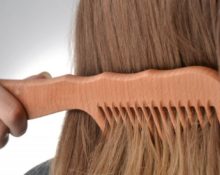Pediculosis is a fairly common disease that is transmitted through close personal interaction or contact with the patient’s belongings. The presence of lice is not at all an indicator of belonging to an asocial environment, but a side effect of children attending preschool and school educational institutions, sports clubs, and summer camps.
If they are detected, a set of correct measures is important both during treatment and after, since there is a high risk of re-infection and secondary infection.. Lice removal should be approached comprehensively, using all available methods: mechanical and chemical. So how do you process them?
Do I need to clean my combs after getting rid of lice?
 The affected area, as well as the room, bedding, personal belongings of the patient, in particular, accessories and hair accessories, combs, combs for combing (including electric ones) are subject to mandatory simultaneous disinsection treatment. Disinfection should be carried out periodically throughout the course of treatment, as well as upon its completion.. The only exceptions are combs with replaceable attachments.
The affected area, as well as the room, bedding, personal belongings of the patient, in particular, accessories and hair accessories, combs, combs for combing (including electric ones) are subject to mandatory simultaneous disinsection treatment. Disinfection should be carried out periodically throughout the course of treatment, as well as upon its completion.. The only exceptions are combs with replaceable attachments.
How and with what to sanitize all the combs in the house?
To sanitize combs, use the full range of available methods:
 specialized products containing insecticidal components in the form of sprays, shampoos, solutions, lotions, emulsions, for example: Medifox, Foxilon, Hygia, Nittifor and others. The procedure is as follows: the combs are placed in one of the preparations for 3 hours, then washed with soap and rinsed thoroughly with hot water. It is more advisable to use several drugs with different active ingredients, since these insects are resistant to many pediculicides;
specialized products containing insecticidal components in the form of sprays, shampoos, solutions, lotions, emulsions, for example: Medifox, Foxilon, Hygia, Nittifor and others. The procedure is as follows: the combs are placed in one of the preparations for 3 hours, then washed with soap and rinsed thoroughly with hot water. It is more advisable to use several drugs with different active ingredients, since these insects are resistant to many pediculicides;- professional chemical compositions: “Avicin”, “Medilis Super”, “Medifox-super” and their analogues. Effective in the fight against lice (adults and nits) due to the high content of antiparasitic toxic substances. When choosing these disinfectants, you must follow the instructions, which describe in detail the application algorithm and dilution concentration. The disadvantage of using it is its high cost.
Folk remedies and methods
There are many popular recipes, here are just a few:
- mix water, table vinegar and hydrogen peroxide in a ratio of 0.5:1:1. Soak the combs in the resulting mixture for 3 hours, then place them in hot water for 20 minutes, wash them in soapy water, and rinse;
- immerse combs and brushes in hellebore water for 20–30 minutes, after the time has elapsed, rinse under running water;
- place the combs in boiling water for 15 minutes or in the freezer for 10–12 hours.
Note that the effectiveness of such treatment methods is lower compared to chemical ones, so we recommend using them as additional.
Important! Cleaning activities must be carried out with gloves.
How many times does this need to be done?
It is necessary to sanitize combs using anti-pediculosis drugs regularly throughout the entire treatment period.. It is better to do this after each use until the signs of the disease are completely eliminated.
After recovery, final disinfection procedures must be carried out.
What else needs to be done for prevention?
To prevent a possible relapse, it is additionally necessary:
 during illness, do not allow the patient’s clean things to come into contact with used ones;
during illness, do not allow the patient’s clean things to come into contact with used ones;- carry out simultaneous processing of all family members, their belongings and shared premises;
- Handle things regularly during and after treatment. As an option, after complete recovery, replace them with new ones.
It’s even better to try to prevent primary infection. You should always adhere to these rules yourself and teach your children:
- Maintain personal hygiene and always use only individual items and accessories when caring;
- do not wear (even temporarily) other people’s things;
- Use only your own bedding.




 0
0





